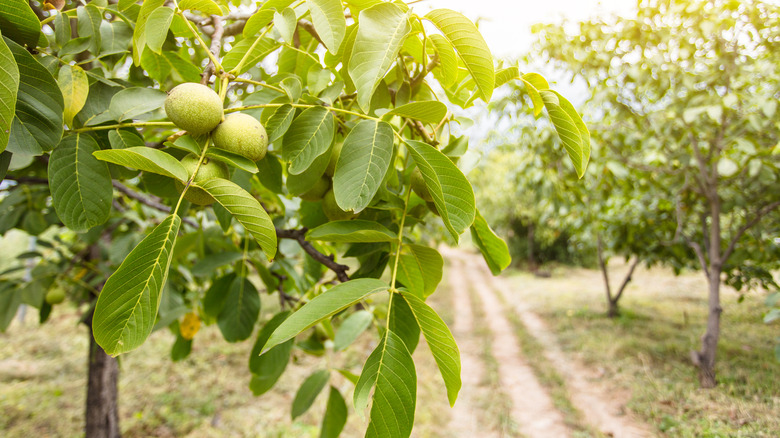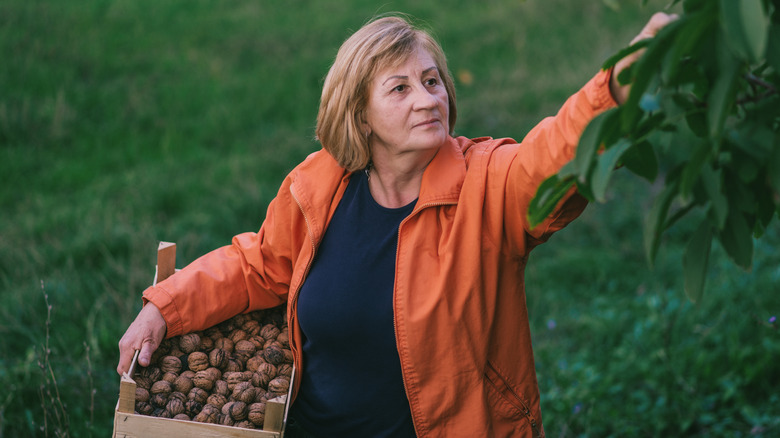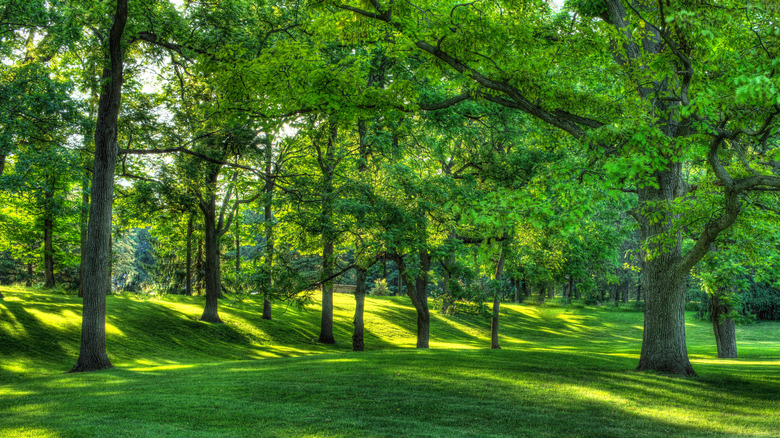The Gardening Myth About A Walnut Tree That's Partly Correct
Native to North America and particularly common around the eastern United States, you've likely seen walnut trees standing alone or in orchards featuring other walnut trees. Their harvesters don't isolate these trees from other plants merely for aesthetic purposes. You've probably heard the myth that nothing grows underneath a walnut tree. Well, this myth is far from baseless since these trees are known to release a powerful chemical called juglone through their roots, hulls, and leaves. This toxin is harmful to a multitude of plants that dominate American gardens, leaving walnut trees off the list of pairs of companion plants you should grow together.
While other trees in the walnut family also produce juglone, walnut trees release the chemical in higher concentrations, putting nearby juglone-sensitive plants at risk. However, not all plants are negatively impacted by walnut trees. Some shrubs and flowers have little reaction to the juglone produced by walnut trees and may appreciate the shade these trees offer. Whether you're considering adding a walnut tree or two to your property or are buying a home with walnut trees already present, it's important to know which plants pair well with the breed, as well as which would experience more harm than good when planted within the tree's reach.
Friends and foes of walnut trees
Black walnut trees have many adversaries that physically suffer if planted too close to their roots or drip line. At the very least, these plants would be kept from growing to their full potential, as exposure to juglone negatively impacts their respiratory systems. In worst-case scenarios, these plants could die due to overexposure since plants need to be able to perform photosynthesis successfully in order to survive. Many of these foes happen to be fruits and vegetables — make sure you don't plant too close to crops like tomatoes, blueberries and apples. Properly distance these crops far enough from your walnut trees' reach in order to avoid contact. Certain flowers also struggle to grow to full size if planted near or underneath walnut trees, including azaleas, chrysanthemums, petunias, and peonies.
Despite their high concentrations of toxicity, walnut trees also have a number of companion plants that find the toxin bearable and aren't as sensitive to the tree's harmful effects. This includes vegetables like carrots, beets, onions, squash, and select types of beans. A wide variety of other trees and flowers also tolerate the juglone produced by walnut trees, including but not limited to oak trees, poplars, red cedars, marigolds, pansies, ferns, and zinnias.
How to incorporate walnut trees into landscaping
Walnut trees grow best in locations that receive ample direct sunlight and fertile, well-drained soil. Even under the best conditions, a tree takes a while to reach full maturity, not even producing any nuts for the first estimated 15 years of its life. Walnut trees also produce little to no juglone during their early years, making this phase the best time to grow plants near the trees that aren't expected to live for very long. However, if working with adult walnut trees, it's best to distance your juglone-intolerant plants at least 50 to 60 feet from the trunk of your tree to ensure its products and roots won't negatively impact their growth and development.
You should think twice before planting walnut trees and nurturing them to full size because once walnut trees have matured, it's extremely difficult to rid your yard of the toxins they've released while rooted in the ground. Even uprooting an existing walnut tree won't resolve the issue entirely since the process won't remove all juglone from the area where the tree was once planted. In other words, planting juglone-averse crops close to where a walnut tree once stood can still have detrimental effects on the crops in question.


